/ 日本語ページインデックス ... English Documents / 掲示板
Strontium 90 ストロンチウム90関連の資料置き場
http://tech.groups.yahoo.com/group/HomeRadLab/message/349
http://tech.groups.yahoo.com/group/HomeRadLab/message/351
New screening method for Sr90 (MDA of 3Bq/Kg for liquid and 5Bq/Kg for solid). Japanese
http://www.fukushima-u.ac.jp/press/H25/pdf/55_05.pdf
http://web.engr.oregonstate.edu/~hambydm/papers/zometsky.pdf
Alpha/Beta Hand and Foot Surface Contamination ... - Fuji Electric catalog
http://www.fujielectric.com/products/radiation/surface/box/doc/ECNO2306b_HFM%28PL%29_NHP21.pdf
Thin Beta-ray Detectors using Plastic Scintillator Combined with Wavelength-shifting Fibers for Surface Contamination Monitoring
http://www.tandfonline.com/doi/pdf/10.1080/18811248.1998.9733961
Optimization of plastic scintillator thicknesses for online beta/gamma detection
http://www.epj-conferences.org/articles/epjconf/pdf/2012/06/epjconf_er2010_07010.pdf
Beta Spectrometers with Surface Barrier Detector and Plastic Scintillator: Applications to 90Sr,204Tl,210Pb and 14C.
http://journals.tubitak.gov.tr/physics/issues/fiz-01-25-2/fiz-25-2-4-0005-6.pdf
Identification of Beta Nuclides Measured by Using Plastic Scintillator AND LIQUID SCINTILLATION COUNTER
http://www.lsc-international.org/conf/pfiles/lsc2008_019.pdf
Plastic Scintillators: A Powerful Tool to Reduce Mixed Waste
http://www.wmsym.org/archives/2008/pdfs/8225.pdf
Beta spectrometry
http://www.bubbletech.ca/radiation_spectrometers_files/beta_probe.html
http://www.qsl.net/k/k0ff/7Manuals/Beta%20Spectrograph/BetaSpectrometer.htm
http://www.qsl.net/k/k0ff/7Manuals/Beta%20Spectrograph/
With photo and illustration (Japanese)
http://www.esi.nagoya-u.ac.jp/h/isets11/jp/ISETS%2711_OpenLecture-S.Oikawa.pdf
http://www.jcac.or.jp/method_sea_6.html
Strontium imaging

http://photozou.jp/photo/show/885961/163885144
http://www.plosone.org/article/info%3Adoi%2F10.1371%2Fjournal.pone.0057760
放射性ストロンチウム・・低バックグラウンドα/β線測定
http://www.radio-isotope.jp/Analysis/analyse_Sr90.html
放射性ストロンチウム・・固相抽出法による測定
http://www.radio-isotope.jp/Analysis/tech_Sr90_raddisk.html
放射性ストロンチウム・・固相抽出法による測定の留意点
http://www.radio-isotope.jp/Analysis/Tech_Sr_remark.html
一之瀬様によるストロンチウム関連情報のまとめ
http://imeasure.cocolog-nifty.com/isotope/2014/03/sr-90-sr-90-1eb.html
Small experiment with Sr90 and Rap-47 低エネルギー用プローブでSr90が見える?という実験
Sr90 Strontium is hard to detect. ストロンチウム90は、検出が難しい、と言われています。
Most probes for gamma spectroscopy cannot detect Sr90, or so they said. ほとんどのガンマ線用測定機では、ストロンチウム90は検出できません、と言われていました。
BUT, Rap-47 seems to detect it! Well, I thought so, at first. でも、RAP−47という私が持っている低エネルギー用のプローブは、Sr90の線源に反応します。(プローブは、一応プロも使っているメーカー製のものですが、他は全部アマチュア用の機材で、全部合わせても5万円以下で購入。専門家の立派な機械による真面目な実験ではありません。)
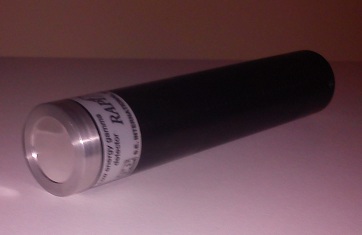
About Rap-47 Rap−47を作っているSi Internationalの製品ページ: http://seintl.com/products/rap_scintillation_probes.html
RAP-47 manual PDF RAP−47のマニュアル: http://seintl.com/manuals/RAPS_Operation_Manual.pdf
Sold at Eebay, too. イーベイでも買えます。 http://www.ebay.com/itm/new-CsI-Tl-RAP47-Low-Energy-Gamma-LEG-ScintillationGeiger-Counter-Probe-XRF-/350814863821
With the confidence I got from previous XRF experiments using Rap-47 + Theremino Pmt Adapter + Theremino Mca, I tested the Sr90 disc source.
Rap−47とテレミノPMTアダプター、そしてテレミノMCAを使って蛍光X線を測る実験で、Rap−47やテレミノPMTアダプターの性能が大体分かってきたので、RAP−47がストロンチウム密封線源の「何に」反応しているのか調べてみました。
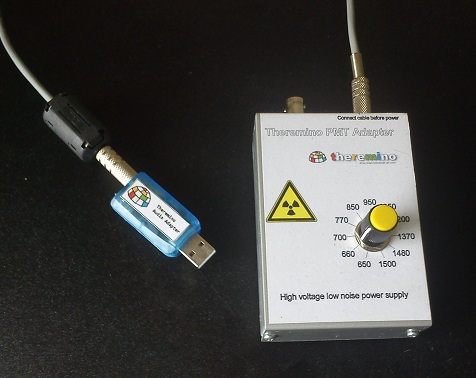
Note: the .spe files are for raw channel data, only. The detector information and the calibration in the file are for my CsI detector and not for Rap-47 SPEファイルは、チャンネルデータ部分のみ有効です、機器情報とかは他の検出器の為のものなので、使えません。
Natural background RAP−47の低エネルギー領域の背景
The biggest background peak is probably from the X-ray of Pb. The smaller peak at around 32KeV shouldn't be from Cs137 as I do not see anything at 662KeV when I measure with other probes at the same time. I think it's X-ray from Iode within CsI crystal, for the moment.一番大きい山が、鉛とかのX線で、これは、私のアパートがコンクリート製で、ウラン系列が結構あるため、そこからのものが多いのではないかと思っています。32KeVの小山は、Cs137(の娘)のX線の位置と同じですが、測定器がCsIなので、そのヨウ素のX線ではないか?と思ってます。他の検出器を使って同時に調べても、Cs137の662KeVは、バックグラウンドには全然ありませんし、線源などは、測定する場所から離れたところに、鉛で遮蔽して、水なども追加して保管しているので、そこからの「コンタミ」ではないでしょう。
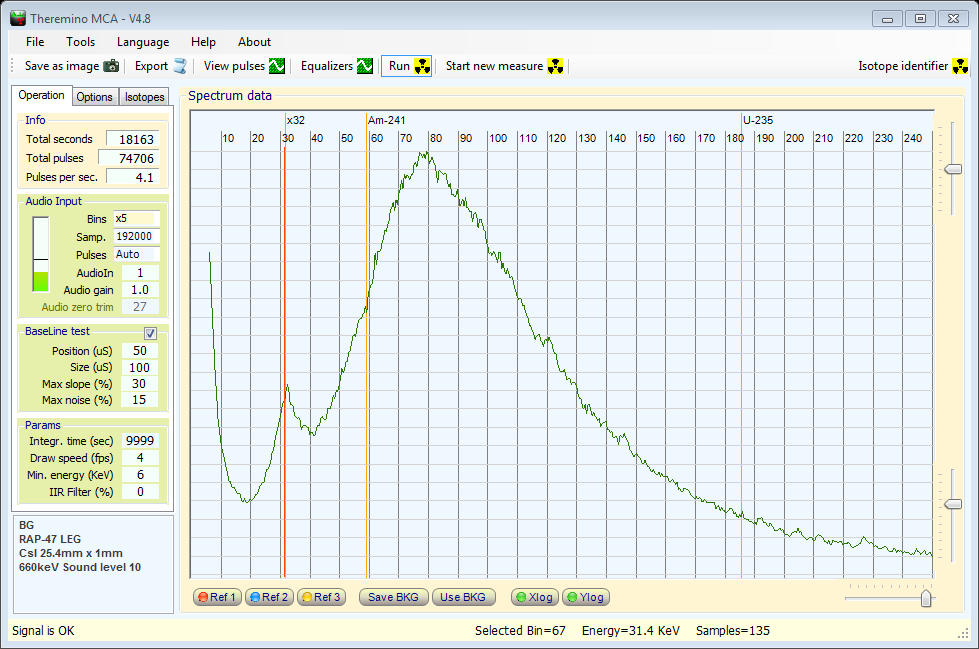
http://pico.dreamhosters.com/img/Sr90/HISTOGRAM_2013_06_17_16_28_47-RAP-47-BG.txt
http://pico.dreamhosters.com/img/Sr90/HISTOGRAM_2013_06_17_16_28_47-RAP-47-BG.spe
Sr90 disc source, plastic side, at 2cm from the detector 線源のプラスチック側を測定機に向け、2cmの位置で測定
More than 500cps ! Mostly under 20KeV, but there are counts (nearly flat) to higher energy without distinct peak.
500cps以上有ります。ピークは10KeV以下のノイズか何かわからないもの。ベータ線特有の、ピークがなく絨毯状に満遍なくカウントが出るスペクトルです。

http://pico.dreamhosters.com/img/Sr90/HISTOGRAM_2013_06_17_17_55_22-RAP-47-Sr90-2cm.txt
http://pico.dreamhosters.com/img/Sr90/HISTOGRAM_2013_06_17_17_55_22-RAP-47-Sr90-2cm.spe
Sr90 disc source, plastic side, at 5cm from the detector プラスチック側、5cm
The count rate goes down to 139cps. But the spectrum pattern is the same. 線源を測定器から離すと、予想通り、カウントの率は低くなりますが、スペクトルのパターンは、変化無し。これは、スペクトルの特性を調べるのに最適の距離やカウント数の場所を探る為や、距離によるスペクトルの変化から、「何が見えているのか?」を推測する為にやっています。
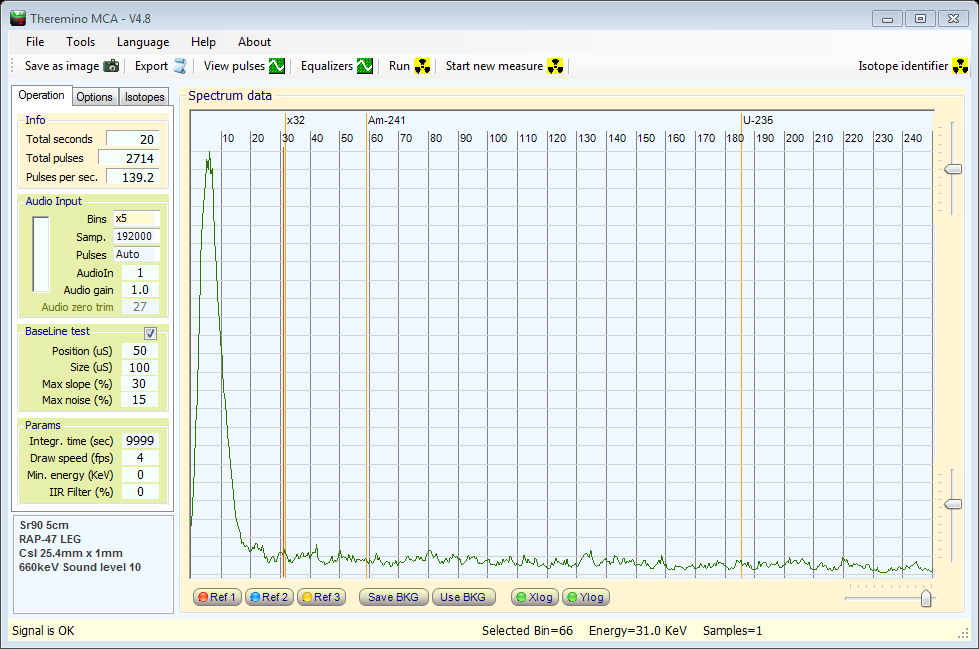
http://pico.dreamhosters.com/img/Sr90/HISTOGRAM_2013_06_17_17_56_07-RAP-47-Sr90-5cm.txt
http://pico.dreamhosters.com/img/Sr90/HISTOGRAM_2013_06_17_17_56_07-RAP-47-Sr90-5cm.spe
Sr90 disc source, plastic side, at 10cm from the detector プラスチック側、10cm
Now, the count rate is down to 43. But the pattern remains. カウントレートは、43cpsに低下。スペクトルは、そのまま。通常、ベータ線は、ガンマ線よりも遠くに飛ばないようですので、離してもピークのスペクトルが変わらない、ということは、「そのピークの部分」については、ベータを見ているのではなく、ガンマ(というか、X線)を見ている、と思えます。
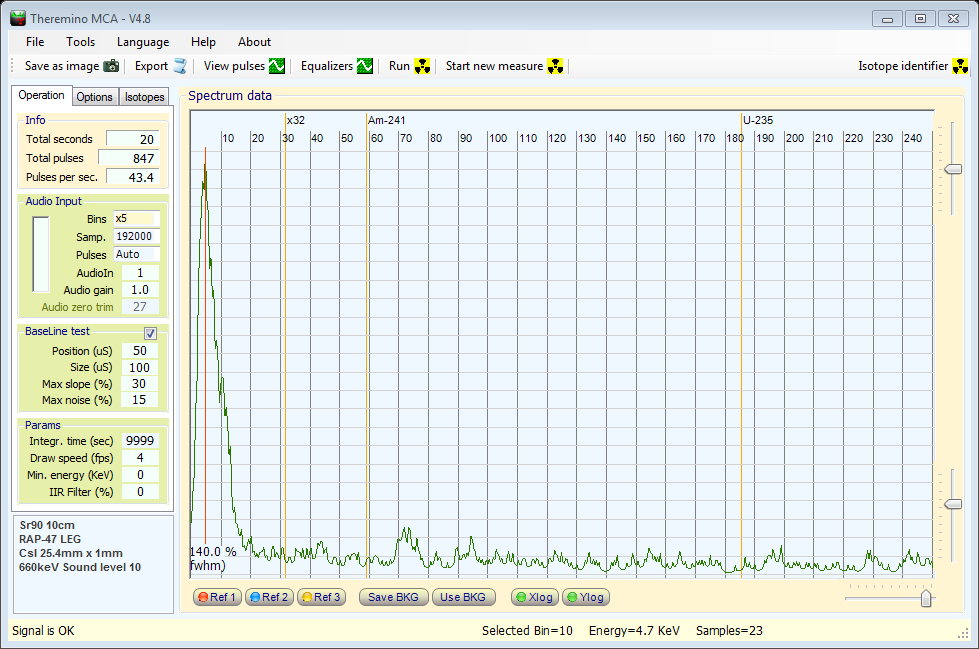
http://pico.dreamhosters.com/img/Sr90/HISTOGRAM_2013_06_17_17_56_07-RAP-47-Sr90-5cm.txt
http://pico.dreamhosters.com/img/Sr90/HISTOGRAM_2013_06_17_17_56_07-RAP-47-Sr90-5cm.spe
Sr90 disc source, plastic side, at 40cm from the detector プラスチック側、40cm
At 40cm from the detector head, the increase in the count rate above background is only 1 or 2cps.
I guess we are seeing mostly the background, here. 測定器から40cmの距離に離すと、背景と比較したcps(毎秒のカウント数)は、1cpsか2cpsに低下。ほとんど背景だけを見ている状態。 山の形状が、最初の背景と違うのは、これは、数十秒の短い測定だからで、カウント数の少ない測定では、長時間かけて、それもしつこく繰り返さないと、どうなるのか分からなかったりします。粘着質のあなたは、ツイッターとかで誰かに粘着してないで、測定をしてみると結構性格的に向いているかも!
(注:誤変換がありましたので、「正確的」を「性格的」に直しました。正確を期すための訂正ですので、集団いじめの対象にしないで下さいね。)
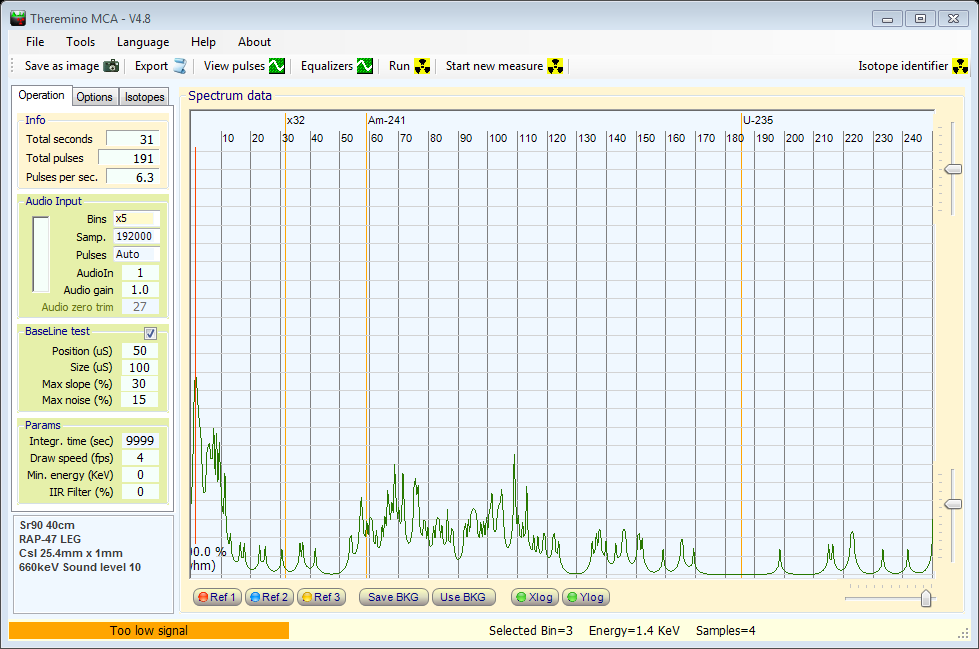
http://pico.dreamhosters.com/img/Sr90/HISTOGRAM_2013_06_17_17_58_19-RAP-47-Sr90-40cm.txt
http://pico.dreamhosters.com/img/Sr90/HISTOGRAM_2013_06_17_17_58_19-RAP-47-Sr90-40cm.spe
Backgorund, again for 30sec 背景の確認。30秒
To make sure, I check the back ground for 30sec, and compare with the data above. 上の結果との比較の為と、同じような秒数で、背景に変化がないことの確認。
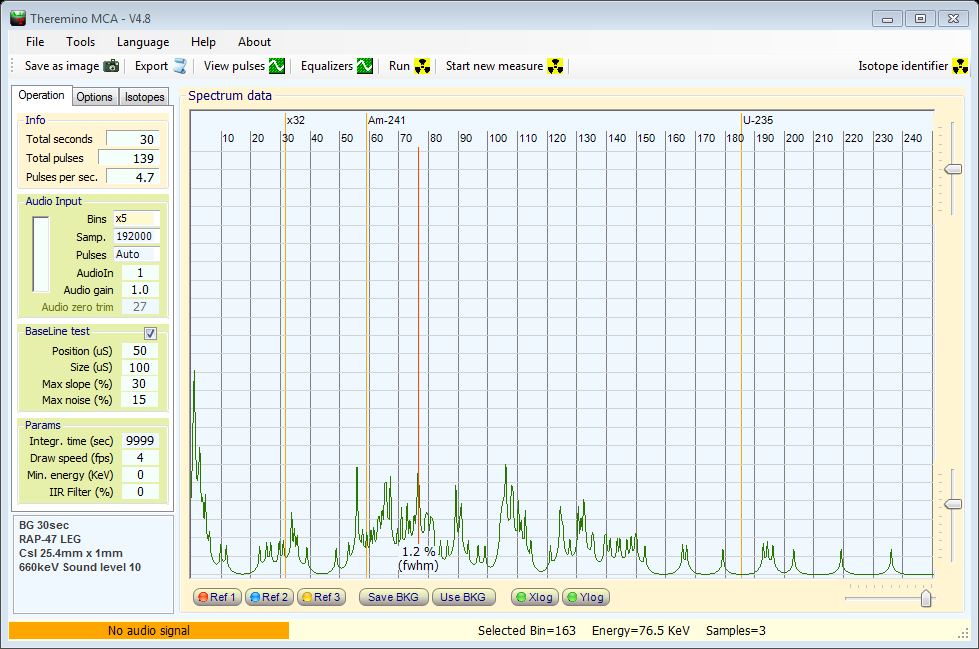
http://pico.dreamhosters.com/img/Sr90/HISTOGRAM_2013_06_17_18_00_12-RAP-47-BG-30sec.txt
http://pico.dreamhosters.com/img/Sr90/HISTOGRAM_2013_06_17_18_00_12-RAP-47-BG-30sec.spe
Sr90 disc source, plastic side, at 10cm from the detector プラスチック側、10cm
I wanted to check the difference between plastic side and the label side. プラスチック側とラベルの紙が貼ってある側の違いを調べようと思いました。
From the plastic side, the peak seems to be around 6KeV. プラスチック側のピークは、6KeV付近。
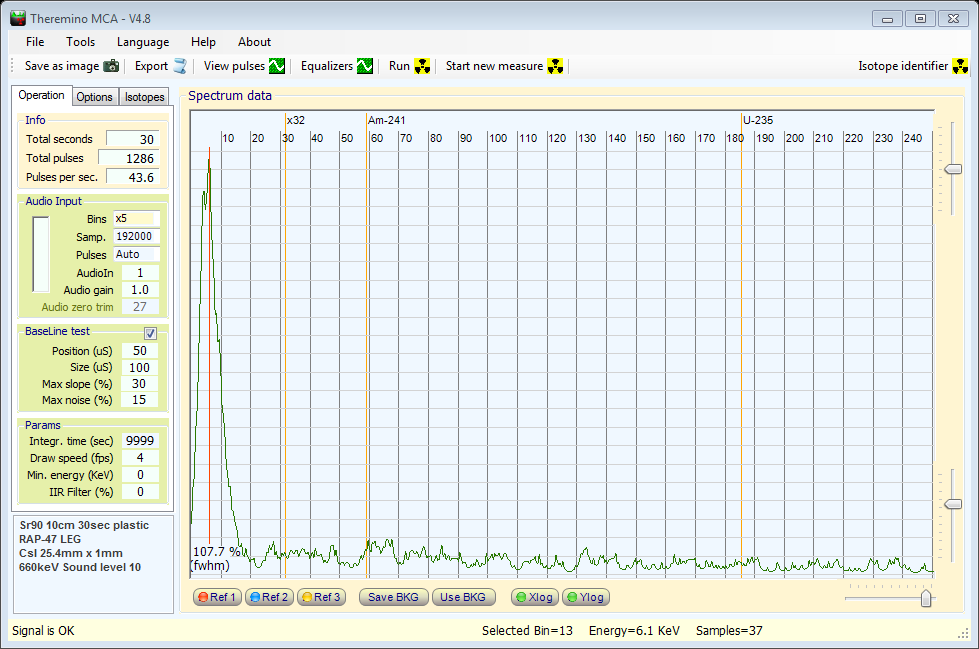
Sr90 disc source, label side, at 10cm from the detector ラベル(紙)側、10cm(同じ距離)
I flipped the source disk to check the spectrum from the label side. 線源をひっくり返して、ラベルのある紙の方を測定器に向ける。
And the peak seems to be slightly lower around 4 to 4.5KeV. そうすると、ピークは、若干低く、4から4.5KeV付近になる。
Also, the count rate is a lot lower compared to the plastic side. また、毎秒のカウント数もプラスチック側よりもかなり低い。
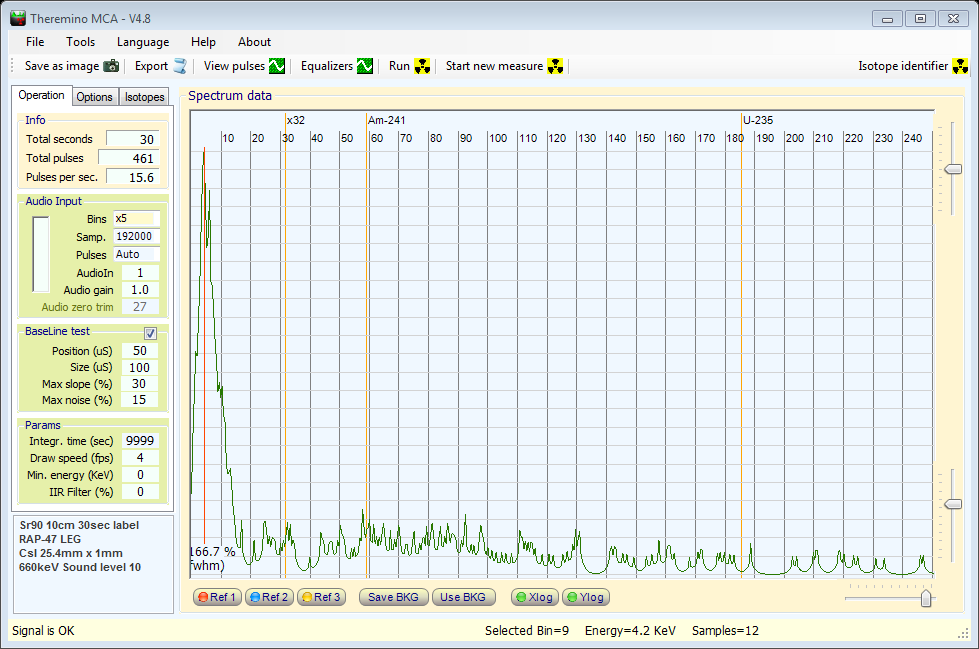
http://pico.dreamhosters.com/img/Sr90/HISTOGRAM_2013_06_17_18_04_55-RAP-47-Sr90-10cm-30sec-label.txt
http://pico.dreamhosters.com/img/Sr90/HISTOGRAM_2013_06_17_18_04_55-RAP-47-Sr90-10cm-30sec-label.spe
Sr90 disc source, plastic side, at 10cm from the detector プラスチック側、10cm
Now, I got interested in the very low energy, where the most counts from (x-ray fluorescence of)
So, I repeated the test magnifying lower energy. Sr90 disc are. 低い領域を良く見る為に、更にズームして再測定。
The peak at 6.6KeV from the plastic side. ピークは、6.6KeV付近。

Sr90 disc source, label side, at 10cm from the detector ラベル(紙)側、10cm
The peak seems to be 4 to 5 KeV, with a spike just below 12KeV. ラベルの方は、4から5KeV.そして12KeV付近に若干あり。
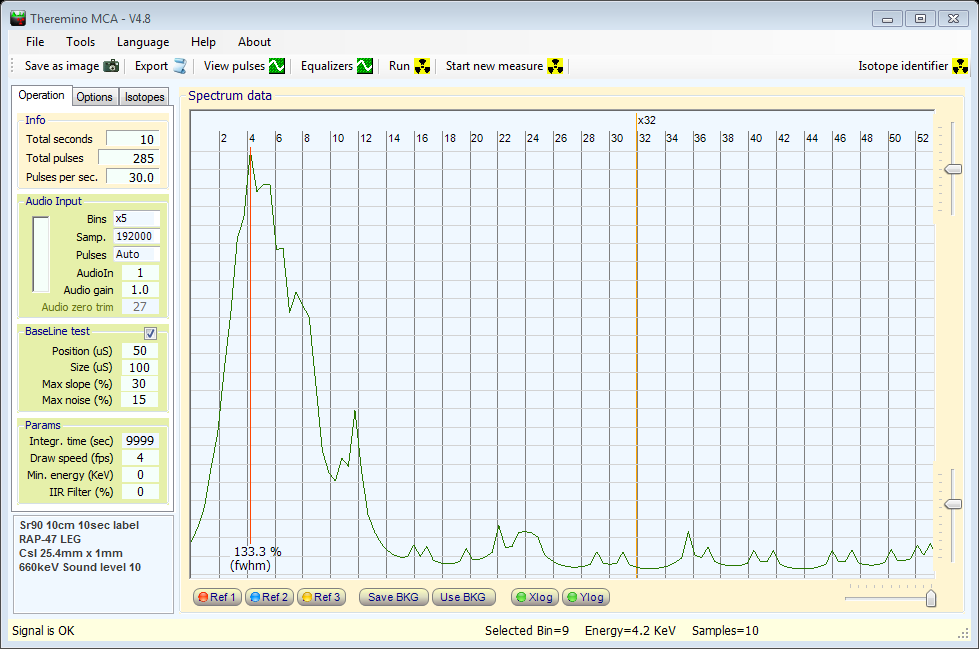
http://pico.dreamhosters.com/img/Sr90/HISTOGRAM_2013_06_17_18_08_28-RAP-47-Sr90-10cm-10sec-label.txt
http://pico.dreamhosters.com/img/Sr90/HISTOGRAM_2013_06_17_18_08_28-RAP-47-Sr90-10cm-10sec-label.spe
Sr90 disc source, label side, at 10cm from the detector 上と、同じ条件。
With the Ref2 (Blue line) showing the plastic side 同じことですが、比較の為に、青い線でプラスチック側の結果を表示。これは、まあまあの性能のプローブで、しつこく確かめないと、単なるズレなどのものか、本当に位置が違うのか、良く分からない程度の小さな違いです。私の測定環境は、蛍光X線の実験で、違う素材を使って繰り返し繰り返し測り直して確認したので、プラスチック側とラベル(紙)の側では、「違いがある」と、かなり自信を持って言うことが出来ます。ただ、それが何のX線なのか?までは、分かるほどの精度はありません。10KeV以下は、素人には結構難しい領域なのです。$6000ドルくらい出すと、Amptekの機械とかぼちぼち買えて、もう少しはっきり分かるようになるので、財力のある方は、試してみて下さい。
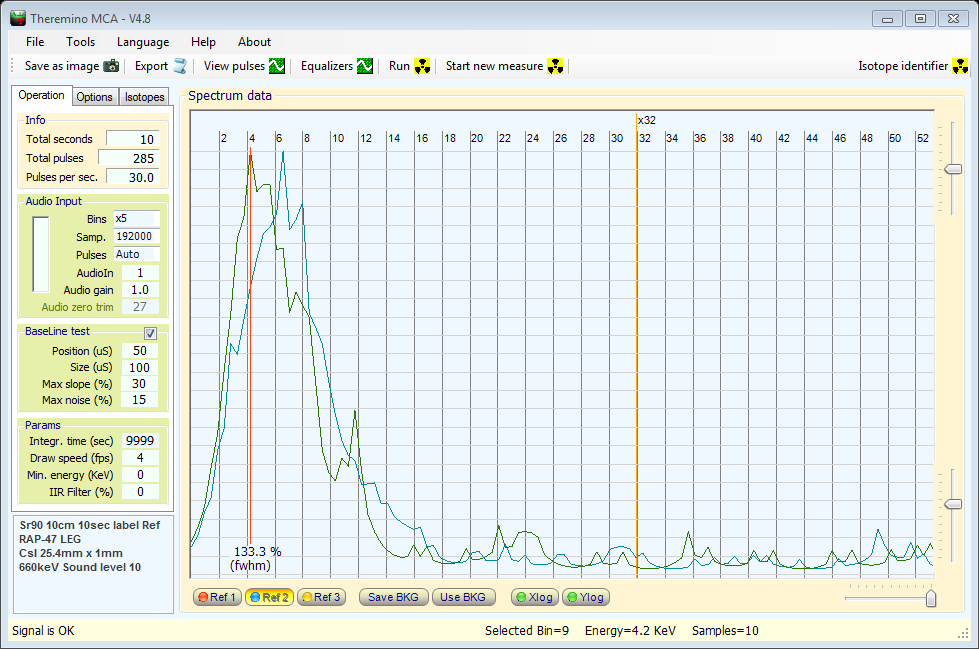
http://pico.dreamhosters.com/img/Sr90/HISTOGRAM_2013_06_17_18_08_28-RAP-47-Sr90-10cm-10sec-label.txt
http://pico.dreamhosters.com/img/Sr90/HISTOGRAM_2013_06_17_18_08_28-RAP-47-Sr90-10cm-10sec-label.spe
I guess the disc source produces lots of XRF with the plastic material (and maybe with paper, etc), and Rap47 could see it, while other detectors could not (because of the lack of sensitivity at lower energy and because of thick aluminum or steel around detector that blocks X-ray).
恐らく、ストロンチウムの標準密封線源は、プラスチック(そしてラベルの紙など)からかなりの蛍光X線を発生しているのではないかと思います。RAP−47は、低エネルギーに特化した非常に薄いCsIの結晶を使い、更に遮光などの為に結晶をカバーしている表面のアルミも極薄仕様なので、この様なエネルギーの低いX線も見ることが出来ます。これに対し、通常のガンマ線用のプローブは、結晶の周囲を1ミリやそれ以上のアルミで覆い、更にその上にケースなどがあったりするので、低エネルギー領域はほとんどブロックされてしまい、見ることが出来ないものが多いです。( Sovtube Detector こと「アルファスペクトラ」 のNaI1.5インチ版では、20KeVの銀の蛍光X線までは見えることを確認しましたが、それ以下は、難しいでしょう) これは、 Software Projects のページにある、放射線の色々な物質による吸収率をグラフで見せる「r6a」というソフトを使うと、分かりやすいです。 Identify Exe を作った会社のフリーソフトで、 Identify Exe にも、同じ計算法やデータが備わっていて、測定器の特性や実験状況をを踏まえた核種判定や推量をするようになっています。
But, maybe we are seeing XRF of Ar in the air or other common materials, too.
Now, I`m not sure at all if we can detect Sr90 in the environment or in the food with this method unless it's extremely contaminated.
At lower contamination level, the peaks below 10KeV would be mixed with background and noises, with my current setup.
しかし、もしかしたら、プラスチックだけではなく、空気中のアルゴンとか、他の蛍光X線が見えているのかもしれません。10KeV以下の領域は、Rap−47でも本当にギリギリのところですし、分解能の面からも、残念ながら詳しくはわかりません。
また、ストロンチウム標準線源はかなり高い線量なので、環境中の低いストロンチウム汚染を現在の私の機器で調べるのは、背景に混ざったりして、恐らく無理でしょう。
I will test again when I get CZT detector (if it works).
CZT測定器(イーベイの中古品。分解能はCsIより良いかもしれないが、感度は低い)が既に届いているので、後ほどそれで再度試してみたいと思います。
後は、プラシンチ(プラスチックシンチレーター)の薄いものを3インチPMTにくっ付けて試す実験、とかも考えています。PMTは安いものを入手済みで、アルファ線検出用のZnS(Ag)膜をくっ付けてテストしているところです。 Alpha Detection
素人核種判定の辿る道 => 「我慢のガンマ線」 => 「金断のX線」 => 「泥沼のベータ線」 => 「薄膜のアルファ線」(私は、この辺までにしておきたい) => 「泡粒と蜜蝋の中性子線」
If someone is fortunate enough to have one of these Amptek detector or something similar/better, please let me know what you can see with the Sr90 disc source (or other sources of Sr90).
nkom AT pico.dreamhosters.com
普通の測定機で試したらどうなるか?というのを、私もやってみました。
I've also tested what happens with more or less ordinary detector.
普通のCsI2.5インチ測定機でも、Sr90(とその娘のY90)の制動X線による、カウントとスペクトルの持ち上がりを確認しました。
核種の判別は出来ないけど、何かある、あるいは、何か違う、のは、「汚染が強い場合には」頑張れば分かるかも。
Strontium Detection Part Two <==ストロンチウム90測定、その2
他の実験 Another experiment with LEG probe
I used the same probe to detect Cs137 (using 32keV Ba133 line) in soil samples and ash.
I think we can detect down to about 10Bq of Cs137 and maybe a little less, depending on the environment.
同じ検出器を使って、汚染土壌中のセシウム137を検出できるか?という実験をしてみました。
セシウム137が10Bqくらい試料に含まれていると、他の色々な条件などにもよりますが、検出できるようです。